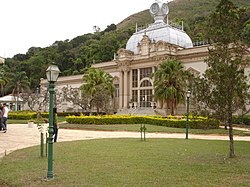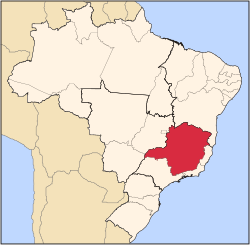Caxambu | |
|---|---|
| Municipality of Caxambu | |
| Nickname: Cidade das Águas | |
| Motto: Medicina entre flores "Medicine among flowers" | |
 Location in Minas Gerais | |
| Coordinates: 21°58′37″S44°55′58″W / 21.97694°S 44.93278°W | |
| Country | |
| State | |
| Region | Southeast |
| Intermediate Region | Pouso Alegre |
| Immediate Region | Caxambu-Baependi |
| Founded | 16 September 1901 |
| Government | |
| • Mayor | Diogo Curi Hauegen (PSDB) |
| Area | |
• Total | 100.203 km2 (38.689 sq mi) |
| Elevation | 895 m (2,936 ft) |
| Population (2021) [2] | |
• Total | 21,566 |
| • Density | 215.22/km2 (557.43/sq mi) |
| Demonym | caxambuense |
| Time zone | UTC−3 (BRT) |
| HDI (2010) | 0.743 – high [3] |
| Website | caxambu |
Caxambu is a Brazilian municipality in Minas Gerais. Its population in 2021 was estimated at 21,566.
Contents
Caxambu is renowned for its spa which has twelve sources of mineral sparkling water flowing 24 hours a day and a cold-water geyser. [4]
- Mineral waters










